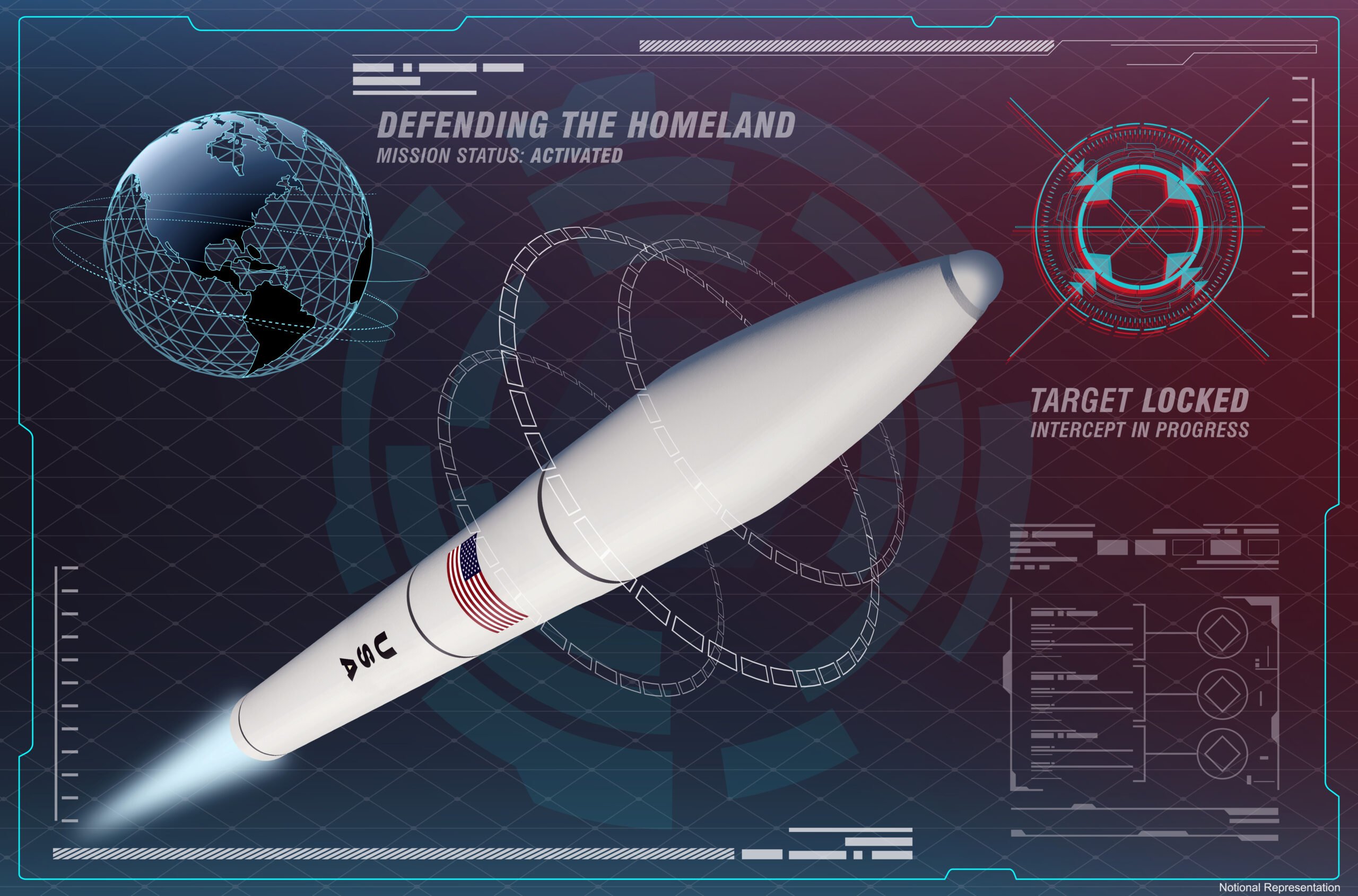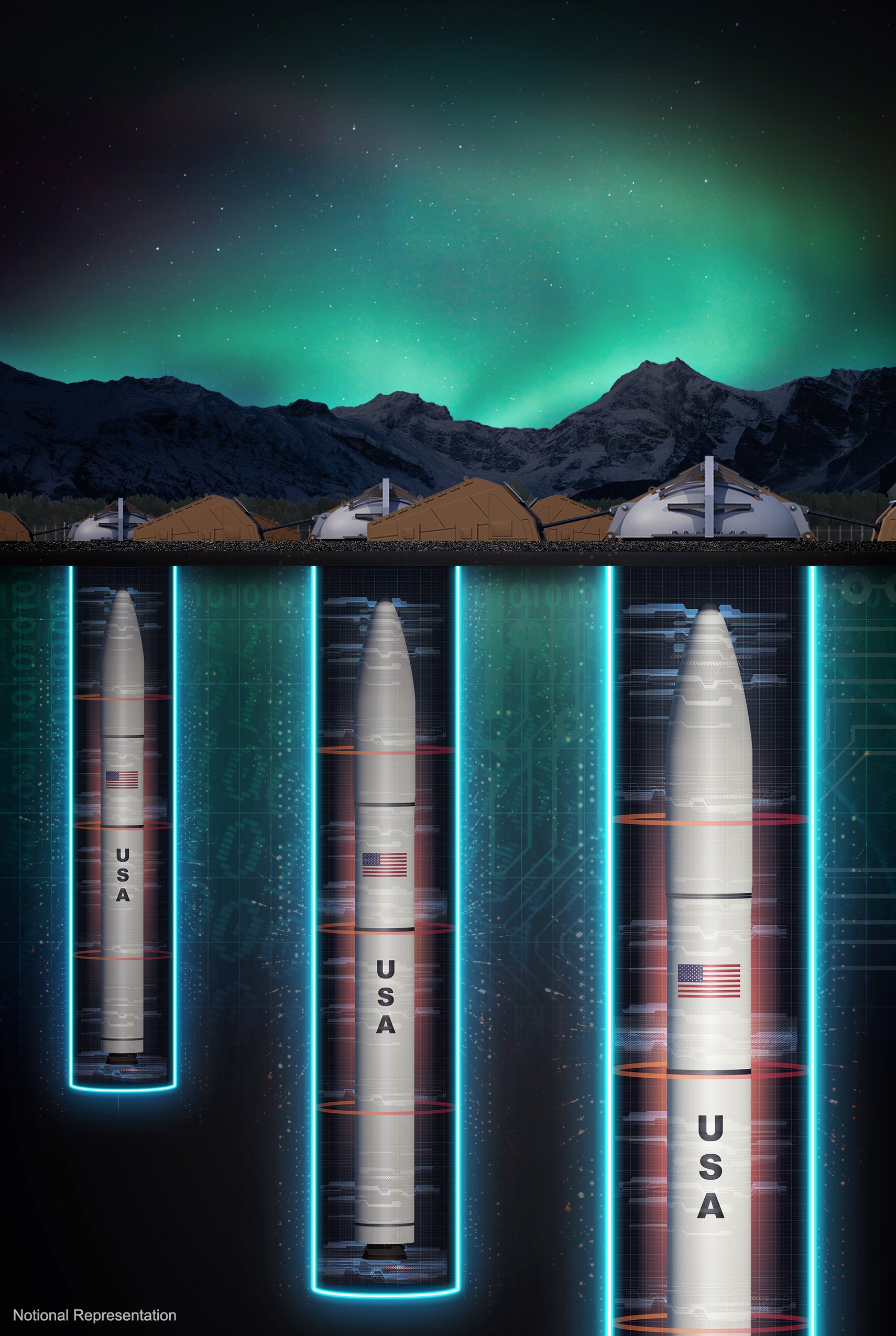
Northrop Grumman is developing the Missile Defense Agency’s Next Generation Interceptor program for the Ground-based Midcourse Defense System. Image courtesy of Northrop Grumman.
The Missile Defense Agency’s (MDA) Next Generation Interceptor (NGI) program is a key element of the Ground-based Midcourse Defense System that is the primary US missile defense system used to defend the country from long-range ballistic missile attacks.
In this Q&A with Lisa Brown, program director for the Next Generation Interceptor at Northrop Grumman, we discuss: how the company is accelerating program development; the importance of digital transformation and the common software factory in developing NGI; its teaming with Raytheon Technologies; and how the company is growing operations in Huntsville to support NGI and other programs.
Breaking Defense: Briefly describe the Next Generation Interceptor mission. How does NGI better counter more advanced ballistic missiles from North Korea and China?

Lisa Brown, program director for the Next Generation Interceptor at Northrop Grumman.
Brown: While our currently deployed homeland defense system can defend against many long-range missile threats, the Missile Defense Agency in 2021 awarded two contracts for the Next Generation Interceptor, which enhances our homeland defense systems and will respond to increasingly advanced missile threats at a moment’s notice.
The current system is capable of countering today’s incoming ICBM threats, but NGI will defeat emerging and more complex threats in the future. We’re incredibly proud of the work that we already do with the Missile Defense Agency across Northrop Grumman. NGI is another opportunity for us to work closely with a customer that we greatly value. There’s no mission more humbling and important to us than defending the homeland, and we look forward to being selected to deliver the production capabilities.
Breaking Defense: What are the next-generation ICBM threats that we’re seeing from places like North Korea?
Brown: I can’t go too deep into this, but the complexity and innovations in the threats are typically related to their maneuverability and countermeasures, and potentially the rate at which the threat is arriving. There are many different technical ways that you can look at why and how the threat evolves. We get those requirements directly from MDA and we perform modeling to prove to them that our overall design for NGI is capable of defeating those threats.
Breaking Defense: Northrop Grumman is teamed with Raytheon Technologies for NGI. Describe the relationship between the two companies?
Brown: Northrop Grumman is the prime and has the ultimate responsibility for the program. Raytheon Technologies is our strategic partner. In general, they’re responsible for a large portion of the payload for NGI.
One of the key cornerstones for both companies is how we empower our teams to think outside the box and come to the table with new ideas to challenge the status quo. Our depth of bench talent is incredibly crucial within systems engineering, modeling for lethality and reliability, as well as process and manufacturing engineering to make our design a reality for when it goes into manufacturing production quantities, as well as for some of the prototypes.
We don’t want to design something that is cost prohibitive. An undercurrent of this innovation and technology is also a mindfulness to focus on affordable solutions as we continue to innovate.

Northrop Grumman’s common software factory for NGI gives MDA transparent access to exactly what the company is writing and including in the design. Image courtesy of Northrop Grumman.
Breaking Defense: Describe the technologies that are playing a role in NGI, such as advanced materials, thermal management, and additive manufacturing.
Brown: Our offering for NGI is a next-generation improvement of many of the technologies that exist within the current infrastructure to defend the homeland. We employ additive manufacturing as a means to rapidly prototype so that we can burn down risk on the program, and also to design our processes, fixtures, and jigs sooner in the overall process. One of the key attributes of the NGI program given its mission and criticality is the speed at which we will execute the program and enable MDA to make a down-select and award a production contract so that we have these systems fielded before they’re needed.
Another of Northrop Grumman’s key strengths is leaning forward for digital transformation. That’s our ability to work in a digital network across the companies and with MDA to give the customer full transparency of all of our tools, models, and software factory and capabilities. It’s through this agile, secure environment that we’re able to design quickly.
The team has also done an incredible job looking for opportunities to move the schedule left. We look at what I call the “long pole in the tent,” which are the riskier aspects of the program for which we do prototyping in manufacturing and small-scale production up front. By time we go into full-scale production, we’ve mitigated those risks.
Breaking Defense: Describe the importance of the manufacturing readiness of the team.
Brown: The Northrop Grumman NGI offering has a strong discriminator related to manufacturing readiness. The reason goes back to something I said earlier. Because of the importance of this mission and the need to field on an accelerated timeline, we intend to give the warfighter what they need before they need it.
Between our factories in Tucson and Chandler, Arizona, as well as the factory in Utah that manufactures the solid rocket motors, we already have steady state manufacturing capability. As soon as the design is completed and the supply chain is turned on for the production components of that design, we can go into manufacturing on a very quick basis after award of the production contract.
Breaking Defense: Discuss a bit more about digital engineering and modeling, and the role of the common software factory that you mentioned earlier.
Brown: The common software factory is a way for us, our partner companies, and MDA to have an up-to-date, transparent capability that looks into our agile and DevSecOps software design process. It gives the customer transparent access to exactly what we are writing and what we’re including in that design, as well as tying back into the overall model for performance for the system. It also gives MDA an ability to course correct and evaluate early how we’re progressing on overall design and development, as well as added insight on risk mitigations and how we’re performing to the schedule.
Our digital infrastructure in Huntsville will play a very important part overall on the program. Our customer and our program office and headquarters are in Huntsville and before the end of 2022, we’ll be moving into a new facility right on the doorstep of Gate 9 at Redstone Arsenal. All of our customer counterparts within MDA are located in Huntsville. There is no better way to have customer intimacy and a high sense of urgency and reaction time to their needs than when you’re sitting right on their doorstep.
Huntsville has a rich history of missile defense, and there’s a lot of key talent and capability in that area that allows us to augment the workforce — both within our own team, as well as with small businesses and other industry partners that we have in the area such as a small business we’re working with called Dese Research that is very important to us from a systems engineering and modeling standpoint. Small businesses think in a different way than sometimes large corporations. It’s good to have that diversity of thought and we certainly value diversity in the ways that it helps us continue to innovate.
We have close to 3,000 employees in Huntsville and continue to grow with new facilities and infrastructure — not just on the NGI program but across Northrop Grumman. We also have a concentrated effort in the community where we focus on veterans’ programs, as well as STEM in the schools.
Breaking Defense: What are the major NGI gates and milestones coming up?
Brown: Let me look backwards for a second. The first major program milestones that were completed mid-2021 were our IBRs, the Integrated Baseline Reviews. We had to perform an IBR not only at the prime level but also for all major subs that had significant contract value.
Going through those baseline reviews and snapping the line on this is how we’re going to execute. Again, not that we won’t continue to evaluate ways to pull that left, but showing how we’re going to execute NGI was a big deal. Similarly, by the end of 2021 we had completed an SRR, which is the Systems Requirements Review.
Looking at the major program milestones going forward, we are focused primarily on the path to Preliminary Design Review, which we anticipate is going to be next year in 2023. With this next major milestone, we’re going to continue to pull left. The program culminates in Critical Design Review, which is currently in 2025.
Breaking Defense: Final thoughts?
Brown: We’re incredibly proud and humbled by the mission, and do not take lightly the responsibility that MDA has placed in us to provide the capability to defend the homeland .
When people are asked, “why do you do what you do,” you can look at your family and friends and the opportunities that we’re given here in the US, and certainly feel in our heart and in our gut the need to protect it. So we take the mission extremely seriously.
Second is our dedication to meeting the requirements in the contract, while also continuing to stress ourselves looking at ways to improve or accelerate that. Third would be that we’re very focused on mitigating risk to fielding dates by using a well-placed mature manufacturing capability across multiple sites.
Last but not least, we talked about the importance of people and also the importance of our customer — making sure that we are situated on their doorstep to be over responsive to their needs and are providing transparency in all of our tools, in the software factory, and in the program’s goals and inchstones to solve problems very quickly so they don’t result in schedule issues.





















